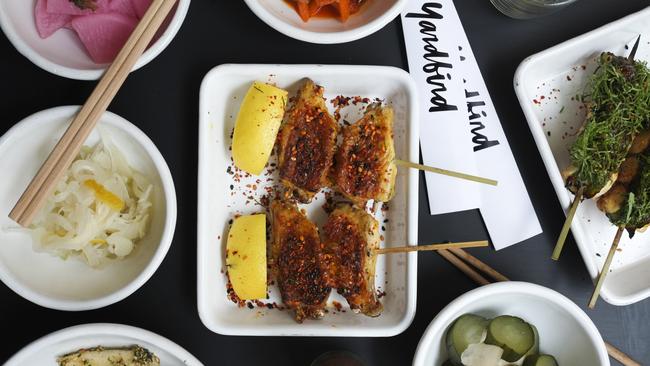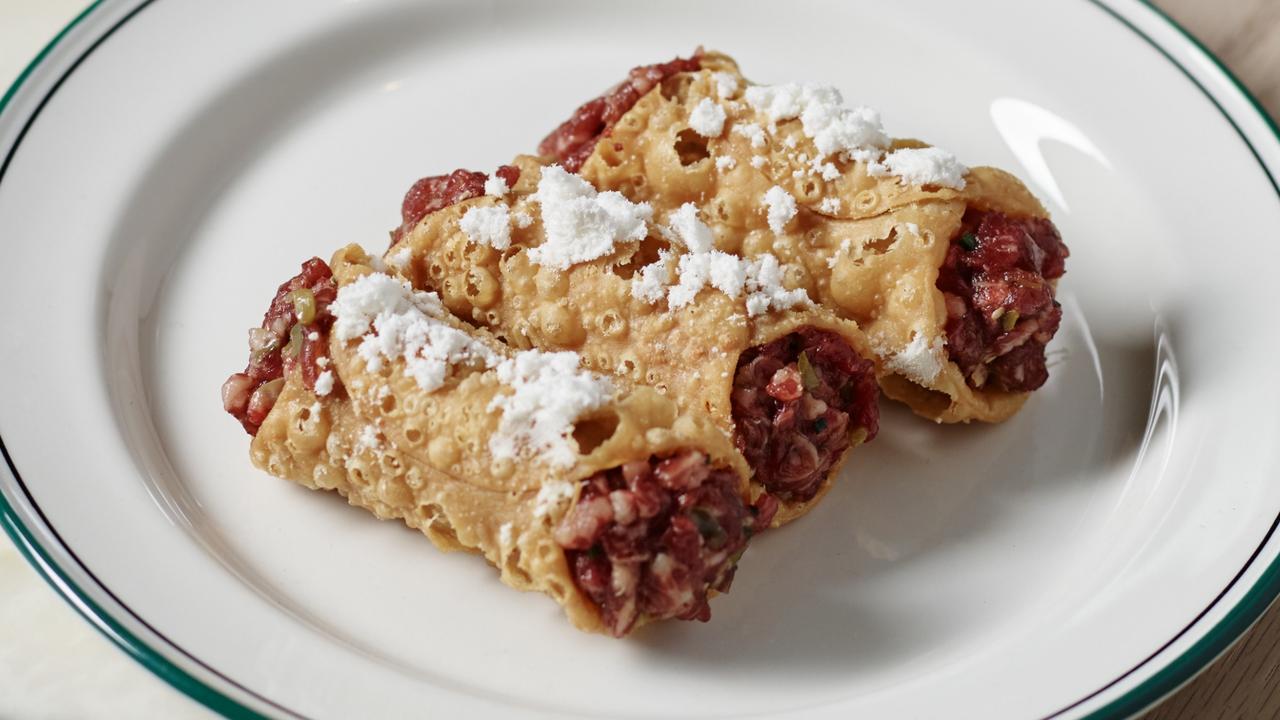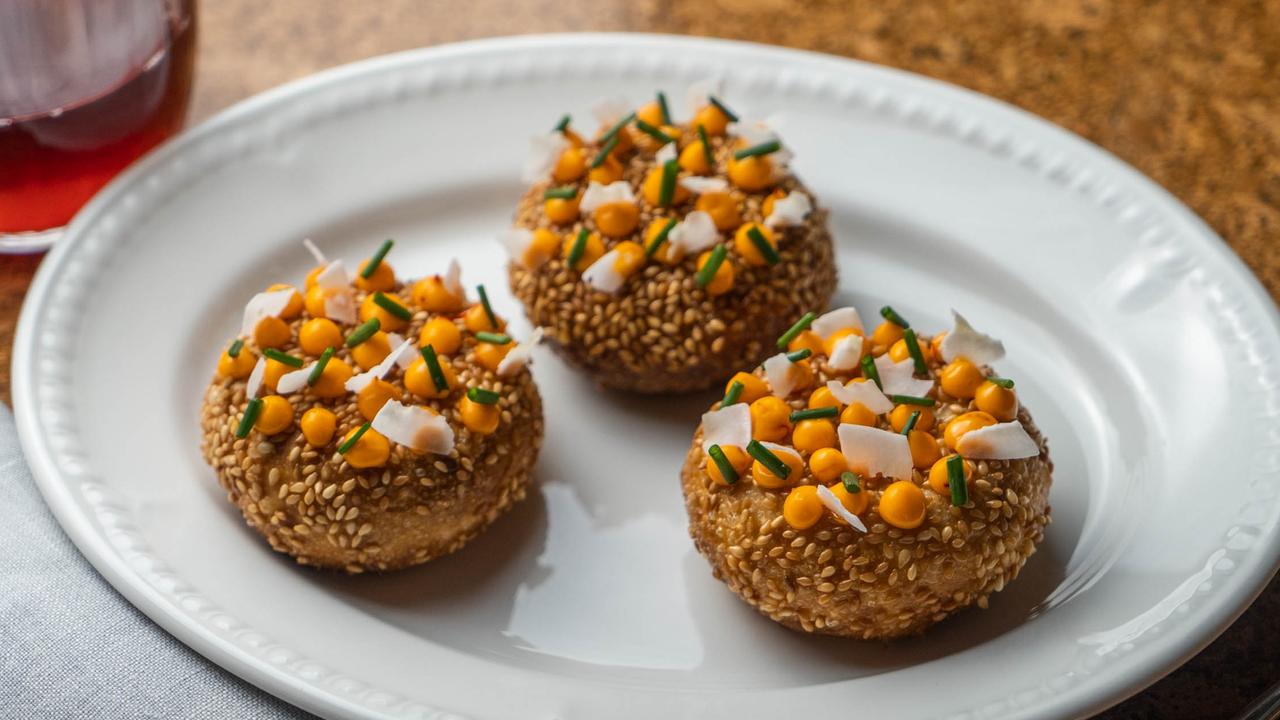Top chefs reveal the art of perfecting yakitori
Like sashimi elevates the humble fish, good yakitori makes boring chicken delectable. Make it at your place with these tips from Melbourne’s top chefs.

delicious.100
Don't miss out on the headlines from delicious.100. Followed categories will be added to My News.
At its core, it’s just chicken on a stick. But so as sashimi is just raw fish, or tempura just battered veg, like other elements of Japanese cuisine, sure it’s that, but it’s so much more.
Yakitori is grilled chicken, elevated to culinary art.
Canadian chef Matt Abergel has spent years learning and perfecting yakitori — Japanese chicken skewers cooked over coal — at Hong Kong’s acclaimed Yardbird.
The chef’s obsession with chicken began when he was a young boy who would cook chook over hot coals every weekend during summer holidays. But it was during his time spent at Masa, New York’s temple of sushi, that he ironically perfected this cooking technique by serving yakitori for his boss, Mayayoshi Takayama, for staff meals.
WHY CURTIS STONE IS RETURN TO MELBOURNE
LUME’S NEW DIRECTION A SHINING LIGHT
“For me, yakitori is a really pure expression of Japanese food, while still being accessible and fun,” Matt says.
“When we opened Yardbird I wanted my friends and family to be able to enjoy and afford to eat at our restaurant whenever they wanted — not needing a special occasion or savings account.”
And it’s worked. Yardbird still attracts queues of diners each night seven years after opening.
They come for all the bits of chicken — from breast and inner thigh and wing through Achilles, soft knee bone and gizzard — artfully skewered and deftly cooked over coal.

Closer to home, yakitori is a feature on the menu at new Japanese restaurant Future Future, while Adam Liston also focused on yakitori at his late-lamented Melbourne restaurant Northern Light and has since introduced Adelaide to the charms of chicken on a stick to winning effect at Shobosho, which is named number 10 in the South Australian delicious. 100.
“I have always had a strong passion for yakitori. I had to try and pull it off in my first restaurant Northern Light with a very backyard BBQ set up,” Adam says. “Luckily in our Adelaide restaurant we had a bigger budget and had learnt from our experiences in Melbourne that we needed a better set up.”
That looks like a double-length yakitori grill with built-in fan that helps control the charcoal temperature and allows for precise cooking.
But at home, a little hibachi (a charcoal stove) and some coal is all you need.
“With the internet now, there are so many options for small at-home grills plus access to great charcoal,” Matt says.


PURE AND SIMPLE
“Yakitori is essentially, and quite literally, grilled chicken. So for me, consistency is what sets yakitori cooking apart,” Atsushi Kawakami at Future Future says.
“The chicken should be as fresh as possible, cut evenly into very small pieces, skewered correctly and to the same weight, and the coals most importantly should have an even distribution of heat across the grill. If you manage to achieve all of this then you have a strong foundation for good yakitori. “
QUALITY EATS
As yakitori is a simple preparation, the key consideration is using fresh, high-quality chicken and good, hardwood charcoal. Binchotan, a slow-burning charcoal, is preferred by Japanese masters but is rare and expensive.
“It’s essential that the chicken you use has never been frozen so that it can cook evenly, without a lot of water retention,” Matt says.
“For the charcoal, use high-quality, clean burning, hardwood charcoal so that
you get as much of the natural chicken flavour as possible.”
COAL FIRED STATION
“I suppose what I love most about cooking over charcoal is the flavour, no other cooking style can produce that char and smoky flavour,” Atsushi says. “(Whether using) Green Egg (an enclosed ceramic charcoal cooker) or a hibachi (Japanese charcoal grill), it’s comfort food that brings people together.”
The appeal of cooking over charcoal is that it just makes food taste better, says Matt.
“Whether it’s primal or not is not for me to say, but everything is just more delicious when cooked over good charcoal.”

CUT TO THE CHASE
While more than 20 different types of yakitori are served at Yardbird, Matt says his favourite cuts are the neck and rib. “Both are very textural pieces, with a great mix of meat and fat, yet both are completely different. I appreciate the neck and rib because these cuts are usually tossed in stock or the garbage.”
Atsushi also rates kubi — chicken neck — highly, along with nankotsu, soft cartilage. “The neck has a similar sort of texture to a hanger steak, and it’s a very popular cut in Japan.”
OFFALLY GOOD
Yakitori is a true beak-to-tail cuisine that makes the most out of every part of the chicken, so offal is a key — and highly prized — component.
Atsushi says it pays to ask your butcher for the freshest offal. “Also, it cooks much quicker than you think. Most people tend to overcook liver or heart just to ‘make sure it’s done’ but trust your instincts.”
Matt agrees. “The key to cooking the liver and heart is relatively aggressive seasoning and making sure you never overcook them. Both should remain pink at the centre. High heat and quick.”

GRILL TEAM
Each cut of meat will be treated differently on the grill.
Atasushi says a good example is tori kawa, chicken skin, as being the fattiest and quickest to burn, it is often re-skewered several times throughout cooking so it’s golden and perfectly crisp.
“The momo, thigh, on the other hand should be well seasoned and rotated occasionally, ensuring it’s juicy and tender.”
SEASON TO TASTE
The two key seasonings used are salt and tare, Atsushi says.
“Tare is a type of sweet and salty sticky sauce used to finish a skewer and the salts can be a mixture of several ingredients, but both are usually quite personal to the Yakitori-ya.”
At Yardbird they usually spray the yakitori with sake and season with moshio — a sea salt cooked down with seaweed.
“I find this salt to be sweeter and have more umami, which allows us to season more aggressively,” Matt says.
Much like a Chinese masterstock, Japanese tare is traditionally never thrown away, never finished and is always evolving, with one batch added to the next. “At Yardbird we still have some elements of the first tare we ever made.”
The current Yardbird tare uses a mix of soy sauces, sake, mirin, sugar, ginger, onion and roasted chicken bones.
“Every yakitori shop has their own version,” he says.
The Future Future version includes umeboshi plum for “a salty sour kick”, while Adam says at Shobosho they dip many of the skewers in tare as they are gilling.
FOR GOODNESS SAKE
“Sake is an ingredient that is always used to balance flavour,” Matt says. “With our yakitori, it gives a light caramelisation and allows us to season with salt a bit heavier. It’s a key component in Japanese cooking as wine is to French cooking.”
Atasushi says they use a combination of sake and mirin — similar to sake, but sweeter with lower alcohol — at Future Future to add depth of flavour and to balance the sauces.
Matt Abergel will be cooking up a yakitori storm at Melbourne Food and Wine Festival’s All the Chickens opening night party on March 8 at the House of Food and Wine (Malthouse Theatre). He will also hold a masterclass on day one (March 9) of the festival’s opening weekend.

RECIPES
CHICKEN YAKITORI SALAD WITH NORI SPRINKLE
Serves: 6
Prep: 2 hours 10 mins
Cook 15 mins
Recipe: Alison Adams, Taste magazine
Ingredients:
750g chicken thigh fillets, trimmed, cut into 3cm pieces
125ml (1/2 cup) Obento Yakitori Sauce
1 sheet nori, crumbled
2 tablespoons white sesame seeds
1-2 teaspoons dried chilli flakes, to taste
2 teaspoons sea salt flakes
90g Hakubaku Organic Soba Noodles
60ml (1/4 cup) Obento Ponzu Sauce
1 small bunch baby broccolini, trimmed, sliced lengthways
100g snow peas, trimmed
100g sugar snap peas, trimmed
110g (3/4 cup) frozen shelled edamame
1 cup watercress sprigs
Pickled ginger, to serve
Method:
Combine the chicken and yakitori sauce in a large glass or ceramic bowl. Cover with plastic wrap and place in the fridge for 2-4 hours to marinate.
Meanwhile, place the nori, sesame seeds, chilli and salt in a frying pan. Cook, stirring, over medium-high heat, for 1 minute or until the sesame seeds are lightly toasted. Transfer to a small bowl. Set aside.
Preheat a barbecue grill or chargrill pan on medium-high. Thread the chicken onto 12 pre-soaked bamboo skewers. Cook, turning often, for 10 minutes or until just cooked. Set aside for 5 minutes to rest.
Cook the noodles in a large saucepan of boiling water, following packet directions. Use tongs to transfer to a colander. Refresh under cold water. Drain well. Transfer to a bowl. Add 1 tbs ponzu sauce. Toss to coat.
Add the broccolini to the boiling water. Cook for 2 minutes. Add the snow peas, sugar snap peas and edamame and cook for a further 3 minutes. Drain and refresh under cold water. Julienne the snow peas.
Arrange the noodles, broccolini, snow peas, sugar snap peas, edamame and watercress on a platter. Drizzle with 1 tbs ponzu sauce. Gently toss to coat. Add pickled ginger and chicken skewers. Sprinkle with the nori mixture and serve with the remaining ponzu sauce.

CHICKEN AND VEGETABLE YAKITORI
Serves: 8
Prep: 20 mins
Cook: 15 mins
Recipe: Cynthia Black, Australian Good Taste
Ingredients:
80ml (1/3 cup) soy sauce
80ml (1/3 cup) mirin (rice wine)
55g (1/4 cup) caster sugar
1 tablespoon rice wine vinegar
2 teaspoons grated fresh ginger
1.3kg chicken thigh fillets, fat trimmed, cut into 3cm pieces
2 medium red capsicums, halved, deseeded, cut into 3cm pieces
8 shallots, pale section only, cut into 4cm lengths
10 (about 100g) fresh shiitake mushrooms
3 Lebanese (slender) eggplant, cut into 2cm-thick slices
Method:
Place the soy sauce, mirin, sugar, vinegar and ginger in a medium glass or ceramic bowl and stir until the sugar dissolves. Reserve half the soy sauce mixture. Add the chicken to the remaining soy sauce mixture and stir to combine. Cover with plastic wrap and place in the fridge for 4 hours to marinate.
Drain the chicken from the marinade. Thread the chicken, capsicum, shallot, mushrooms and eggplant onto the skewers.
Preheat a barbecue grill or chargrill on medium. Add the skewers and cook, turning occasionally, for 15 minutes or until browned and cooked through.
Meanwhile, place the reserved soy sauce mixture in a small saucepan over medium heat. Bring to the boil. Simmer for 2 minutes or until the sauce thickens.
Place the skewers on a serving platter. Serve with the sauce.
Notes:
You’ll need to soak 16 bamboo skewers in water for 1 hour for this recipe. Time plan tip: Prepare to the end of step 1 up to 6 hours ahead. Store reserved soy sauce mixture, covered, in fridge. Continue to end of step 2 up to 2 hours ahead. Cover and store in the fridge. Continue from step 3, 15 minutes before serving.



